Lattice Boltzmann Simulation on Droplet Flow through 3D Metal Foam
Abstract
1. Introduction
2. Experimental
2.1. Experimental Setup
2.2. Metal Foam Micro-Tomography
3. Simulation
3.1. Lattice Boltzmann Equations
3.2. Computational Domain of Droplet Breakup
4. Discussion
4.1. Dimensionless Parameters
4.2. Modeling Coefficients and Validation of LBM Simulation
4.3. The Effect of Ca
4.4. The Impact of Dd
4.5. The Impact of Ld
4.6. The Impact of Db
5. Conclusions
Supplementary Materials
Author Contributions
Funding
Conflicts of Interest
References
- Chen, H.; Yu, H.; Tang, Y.; Pan, M.; Feng, P.; Wang, H.; Peng, F.; Yang, J. Assessment and optimization of the mass-transfer limitation in a metal foam methanol microreformer. App. Catal. A 2008, 337, 155–162. [Google Scholar] [CrossRef]
- Wenmakers, P.W.A.M.; Schaaf, J.V.D.; Kuster, B.F.M.; Schouten, J.C. “Hairy Foam”: Carbon nanofibers grown on solid carbon foam. A fully accessible, high surface area, graphitic catalyst support. J. Mater. Chem. 2008, 18, 2426–2436. [Google Scholar] [CrossRef]
- Stemmet, C.P.; Meeuwse, M.; Schaaf, J.V.D.; Kuster, B.F.M.; Schouten, J.C. Gas-liquid mass transfer and axial dispersion in solid foam packing. Chem. Eng. Sci. 2007, 62, 5444–5450. [Google Scholar] [CrossRef]
- Yu, X.; Wen, Z.; Lin, Y.; Tu, S.T.; Wang, Z.; Yan, J. Intensification of biodiesel synthesis using metal foam reactors. Fuel 2010, 89, 3450–3456. [Google Scholar] [CrossRef]
- Stemmet, C.P.; Jongmans, J.N.; Schaaf, J.V.D.; Kuster, B.F.M.; Schouten, J.C. Hydrodynamics of gas–liquid counter-current flow in solid foam packings. Chem. Eng. 2005, 60, 6422–6429. [Google Scholar] [CrossRef]
- Kim, S.M.; Ghiaasiaan, S.M. Numerical Modeling of Laminar Pulsating Flow in Porous Media. J. Fluids Eng. 2009, 131, 041203. [Google Scholar] [CrossRef]
- Koponen, A.; Kataja, M.; Timonen, J.; Kandhai, D. Simulations of Single-Fluid Flow in Porous Media. Int. J. Mod. Phys. C 1998, 9, 1505–1521. [Google Scholar] [CrossRef]
- Chung, C.; Ahn, K.H.; Lee, S.J. Numerical study on the dynamics of droplet passing through a cylinder obstruction in confined microchannel flow. J. Non-Newton. Fluid 2009, 162, 38–44. [Google Scholar] [CrossRef]
- Lee, J.; Lee, W.; Son, G. Numerical study of droplet breakup and merging in a microfluidic channel. J. Mech. Sci. Technol. 2013, 27, 1693–1699. [Google Scholar] [CrossRef]
- Sethian, J.A.; Smereka, P. Level set methods for fluid interfaces. Annu. Rev. Fluid Mech. 2003, 35, 341–372. [Google Scholar] [CrossRef]
- Lee, W.; Son, G. Numerical study of obstacle configuration for droplet splitting in a microchannel. Comput. Fluids 2013, 84, 351–358. [Google Scholar] [CrossRef]
- Qian, J.Y.; Li, X.J.; Gao, Z.X.; Jin, Z.J. Mixing efficiency and pressure drop analysis of liquid-liquid two phases flow in serpentine microchannels. J. Flow Chem. 2019, 9, 187–197. [Google Scholar] [CrossRef]
- Qian, J.Y.; Li, X.J.; Gao, Z.X.; Jin, Z.J. Mixing efficiency analysis on droplet formation process in microchannels by numerical methods. Processes 2019, 7, 33. [Google Scholar] [CrossRef]
- Juric, D.; Tryggvason, G. A front-tracking method for dendritic solidification. J. Comput. Phys. 1996, 123, 127–148. [Google Scholar] [CrossRef]
- Yang, X.; James, A.J.; Lowengrub, J.; Zheng, X.; Cristini, V. An adaptive coupled level-set/volume-of-fluid interface capturing method for unstructured triangular grids. J. Comput. Phys. 2006, 217, 364–394. [Google Scholar] [CrossRef]
- Scardovelli, R.; Zaleski, S. Direct numerical simulation of free-surface and interfacial flow. Annu. Rev. Fluid Mech. 1999, 31, 567–603. [Google Scholar] [CrossRef]
- He, X.; Chen, S.; Zhang, R. A lattice boltzmann scheme for incompressible multiphase flow and its application in simulation of rayleigh–taylor instability. J. Comput. Phys. 1999, 152, 642–663. [Google Scholar] [CrossRef]
- Qian, J.Y.; Li, X.J.; Wu, Z.; Jin, Z.J.; Sunden, B. A comprehensive review on liquid–liquid two-phase flow in microchannel: Flow pattern and mass transfer. Microfluid. Nanofluid. 2019, 23, 116. [Google Scholar] [CrossRef]
- Boomsma, K.; Poulikakos, D.; Ventikos, Y. Simulations of flow through open cell metal foams using an idealized periodic cell structure. Int. J. Heat Fluid Flow 2003, 24, 825–834. [Google Scholar] [CrossRef]
- Kopanidis, A.; Theodorakakos, A.; Gavaises, E.; Bouris, D. 3d numerical simulation of flow and conjugate heat transfer through a pore scale model of high porosity open cell metal foam. Int. J. Heat Mass Transf. 2010, 53, 2539–2550. [Google Scholar] [CrossRef]
- Montminy, M.D.; Tannenbaum, A.R.; Macosko, C.W. The 3d structure of real polymer foams. J. Colloid Interf. Sci. 2004, 280, 202–211. [Google Scholar] [CrossRef] [PubMed]
- Carvalho, T.P.D.; Morvan, H.P.; Hargreaves, D.; Oun, H.; Kennedy, A. Experimental and Tomography-Based CFD Investigations of the Flow in Open Cell Metal Foams with Application to Aero Engine Separators. In Proceedings of the ASME Turbo Expo 2015: Turbine Technical Conference and Exposition, Montreal, QC, Canada, 15–19 June 2015; p. V05CT15A028. [Google Scholar]
- Aidun, C.K.; Clausen, J.R. Lattice-Boltzmann method for complex flows. Rev. Fluid Mech. 2010, 42, 439–464. [Google Scholar] [CrossRef]
- Zhang, J. Lattice boltzmann method for microfluidics: Models and applications. Microfluid. Nanofluid. 2011, 10, 1–28. [Google Scholar] [CrossRef]
- Wu, L.; Tsutahara, M.; Kim, L.S.; Ha, M.Y. Three-dimensional lattice boltzmann simulations of droplet formation in a cross-junction microchannel. Int. J. Multiphase Flow 2008, 34, 852–864. [Google Scholar] [CrossRef]
- Liu, H.; Zhang, Y. Phase-field modeling droplet dynamics with soluble surfactants. J. Comput. Phys. 2010, 229, 9166–9187. [Google Scholar] [CrossRef]
- Wang, W.; Liu, Z.; Jin, Y.; Cheng, Y. Lbm simulation of droplet formation in micro-channels. Chem. Eng. J. 2011, 173, 828–836. [Google Scholar] [CrossRef]
- Rothman, D.H.; Keller, J.M. Immiscible cellular-automaton fluids. J. Stat. Phys. 1988, 52, 1119–1127. [Google Scholar] [CrossRef]
- He, X.; Doolen, G.D. Thermodynamic foundations of kinetic theory and lattice boltzmann models for multiphase flows. J. Stat. Phys. 2002, 107, 309–328. [Google Scholar] [CrossRef]
- Grunau, D.; Chen, S.; Eggert, K. A lattice boltzmann model for multiphase fluid flows. Phys. Fluids A 1993, 5, 2557–2562. [Google Scholar] [CrossRef]
- Shan, X.; Chen, H. Lattice boltzmann model for simulating flows with multiple phases and components. Phys. Rev. E 1993, 47, 1815–1819. [Google Scholar] [CrossRef]
- Shan, X.; Chen, H. Simulation of nonideal gases and liquid-gas phase transitions by the lattice boltzmann equation. Phys. Rev. E 1994, 49, 2941–2948. [Google Scholar] [CrossRef] [PubMed]
- Hou, S.; Shan, X.; Zou, Q.; Doolen, G.D.; Soll, W.E. Evaluation of two lattice boltzmann models for multiphase flows. J. Comput. Phys. 1997, 138, 695–713. [Google Scholar] [CrossRef]
- Li, Q.; Chai, Z.; Shi, B.; Liang, H. Deformation and breakup of a liquid droplet past a solid circular cylinder: A lattice boltzmann study. Phys. Rev. E 2014, 90, 043015. [Google Scholar] [CrossRef] [PubMed]
- Park, J.; Li, X. Multi-phase micro-scale flow simulation in the electrodes of a pem fuel cell by lattice boltzmann method. J. Power Sources 2008, 178, 248–257. [Google Scholar] [CrossRef]
- Frank, X.; Perré, P.; Li, H.Z. Lattice boltzmann investigation of droplet inertial spreading on various porous surfaces. Phys. Rev. E 2015, 91, 052405. [Google Scholar] [CrossRef] [PubMed]
- Tölke, J.; Krafczyk, M.; Schulz, M.; Rank, E. Lattice boltzmann simulations of binary fluid flow through porous media. Philos. Trans. A Math. Phys. Eng. Sci. 2002, 360, 535–545. [Google Scholar] [CrossRef]
- Beugre, D.; Calvo, S.; Dethier, G.; Crine, M.; Toye, D.; Marchot, P. Lattice boltzmann 3d flow simulations on a metallic foam. J. Comput. Appl. Math. 2010, 234, 2128–2134. [Google Scholar] [CrossRef]
- Cornubert, R.; d’Humiè, D.; Levermore, R. A Knudsen layer theory for lattice gases. Phys. D 1991, 47, 241–259. [Google Scholar] [CrossRef]
- Orlanski, I. A simple boundary condition for unbounded hyperbolic flows. J. Comput. Phys. 1976, 21, 251–269. [Google Scholar] [CrossRef]
- Chen, L.; Kang, Q.; Mu, Y.; He, Y.L.; Tao, W.Q. A critical review of the pseudopotential multiphase lattice Boltzmann model: Methods and applications. Int. J. Heat Mass Transf. 2014, 76, 210–236. [Google Scholar] [CrossRef]
- Liu, H.; Ju, Y.; Wang, N.; Xi, G.; Zhang, Y. Lattice boltzmann modeling of contact angle and its hysteresis in two-phase flow with large viscosity difference. Phys. Rev. E 2015, 92, 033306. [Google Scholar] [CrossRef] [PubMed]
- Stamenković, O.S.; Todorović, Z.B.; Lazić, M.L.; Veljković, V.B.; Skala, D.U. Kinetics of sunflower oil methanolysis at low temperatures. Bioresour. Technol. 2008, 99, 1131–1140. [Google Scholar]
- Noureddini, H.; Zhu, D. Kinetics of transesterification of soybean oil. J. Am. Oil Chem. Soc. 1997, 74, 1457–1463. [Google Scholar] [CrossRef]
- Yan, Y.Y.; Zu, Y.Q. Numerical Modelling Based on Lattice Boltzmann Method of the Behaviour of Bubbles Flow and Coalescence in Microchannels. In Proceedings of the 2008 International Conference on Nanochannels, Microchannels, and Minichannels (ASME 2008), Darmstadt, Germany, 23–25 June 2008; pp. 313–319. [Google Scholar]
- Li, J.; Renardy, Y.Y.; Renardy, M. Numerical simulation of breakup of a viscous drop in simple shear flow through a volume-of-fluid method. Phys. Fluids 2000, 12, 269–282. [Google Scholar] [CrossRef]
- Grace, H.P. Dispersion phenomena in high viscosity immiscible fluid systems and application of static mixers as dispersion devices in such systems. Chem. Eng. Commun. 1982, 14, 225–277. [Google Scholar] [CrossRef]
- Puyvelde, P.V.; Yang, H.; Mewis, J.; Moldenaers, P. Breakup of filaments in blends during simple shear flow. J. Rheol. 2000, 44, 1401–1415. [Google Scholar] [CrossRef][Green Version]
- Cristini, V.; Guido, S.; Alfani, A.; Bławzdziewicz, J.; Loewenberg, M. Drop breakup and fragment size distribution in shear flow. J. Rheol. 2003, 47, 1283–1298. [Google Scholar] [CrossRef]
- Rallison, J.M. A numerical study of the deformation and burst of a viscous drop in general shear flows. J. Fluid Mech. 1981, 109, 465–482. [Google Scholar] [CrossRef]
- Deroussel, P.; Khakhar, D.V.; Ottino, J.M. Mixing of viscous immiscible liquids. part 1: Computational models for strong–weak and continuous flow systems. Chem. Eng. Sci. 2001, 56, 5511–5529. [Google Scholar] [CrossRef]
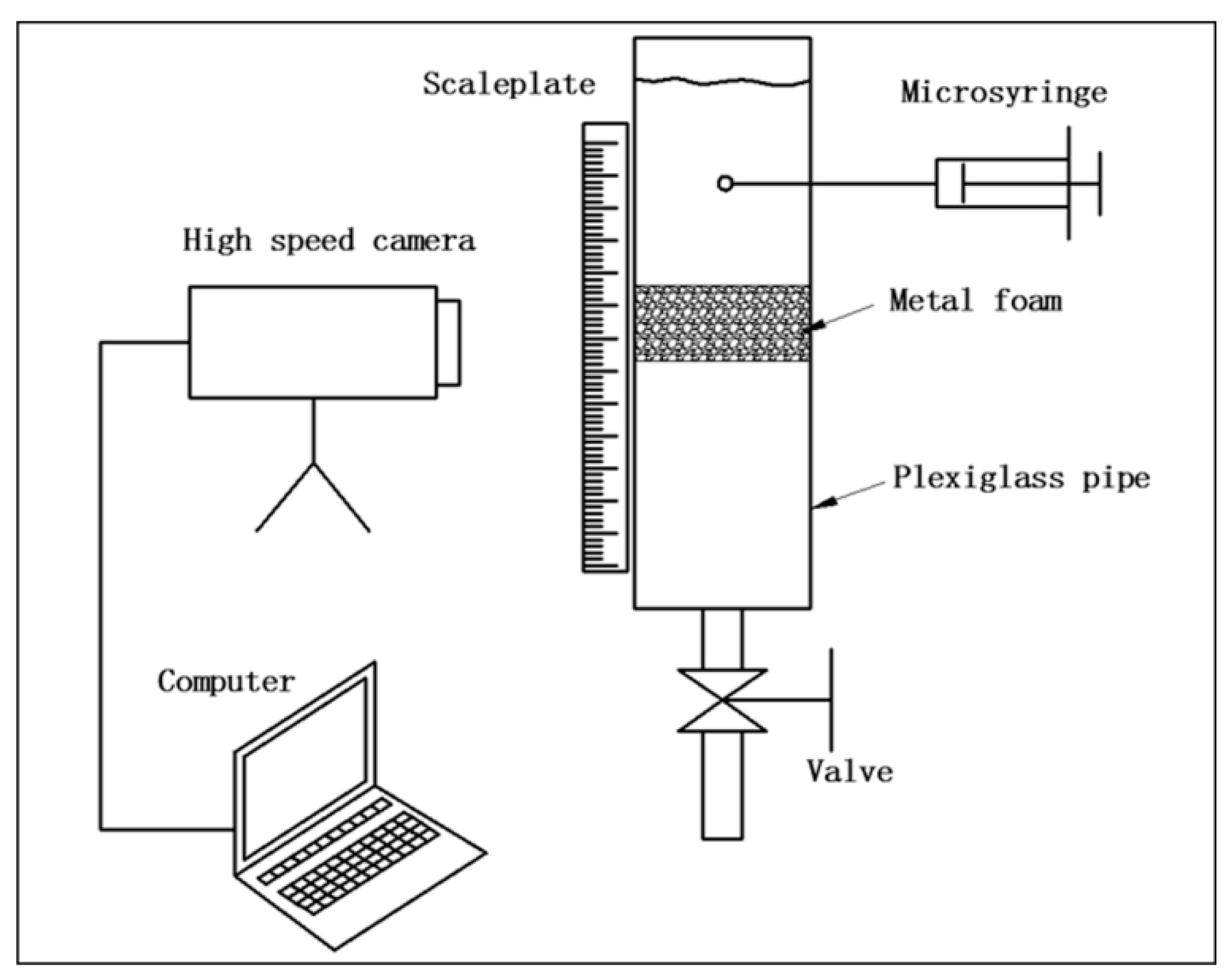

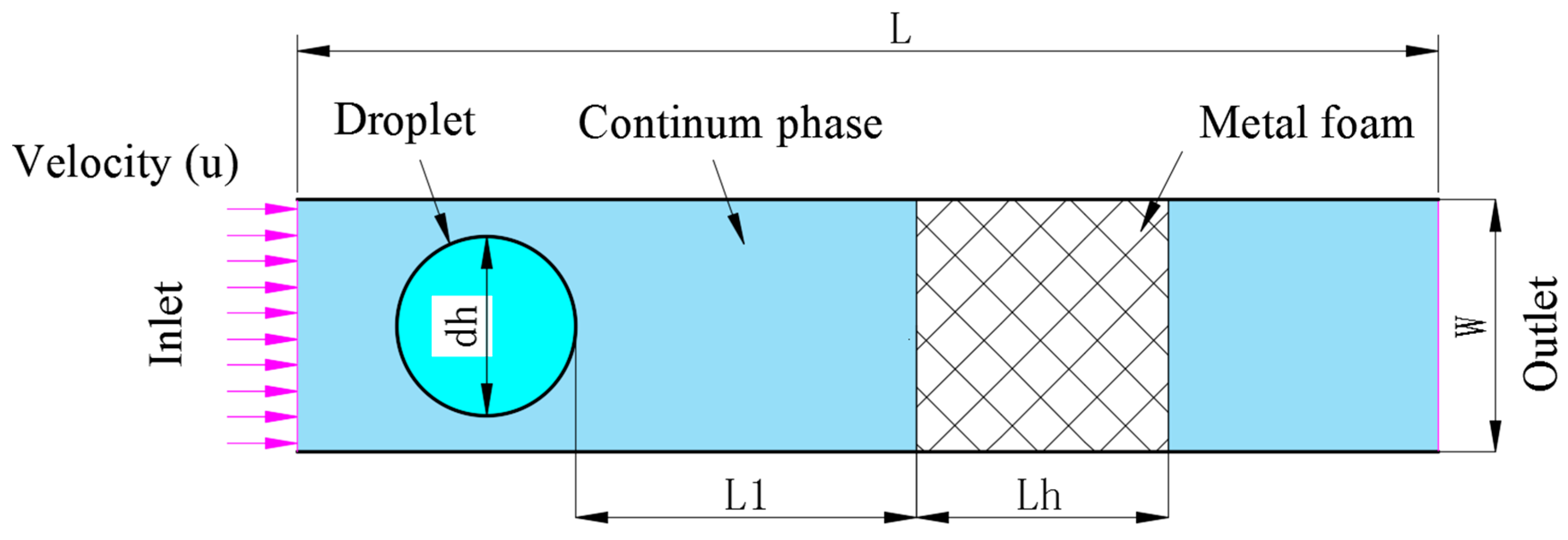
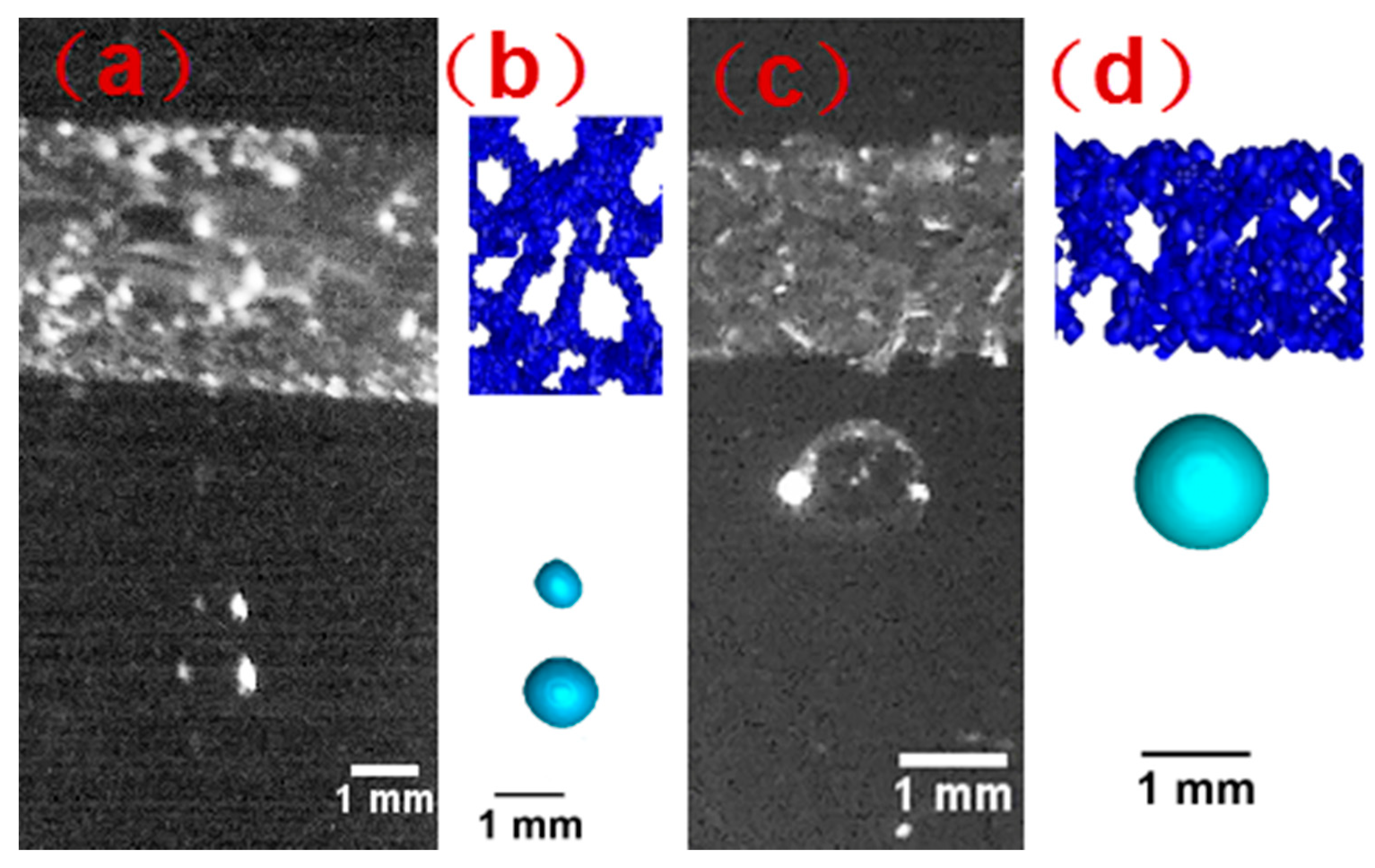

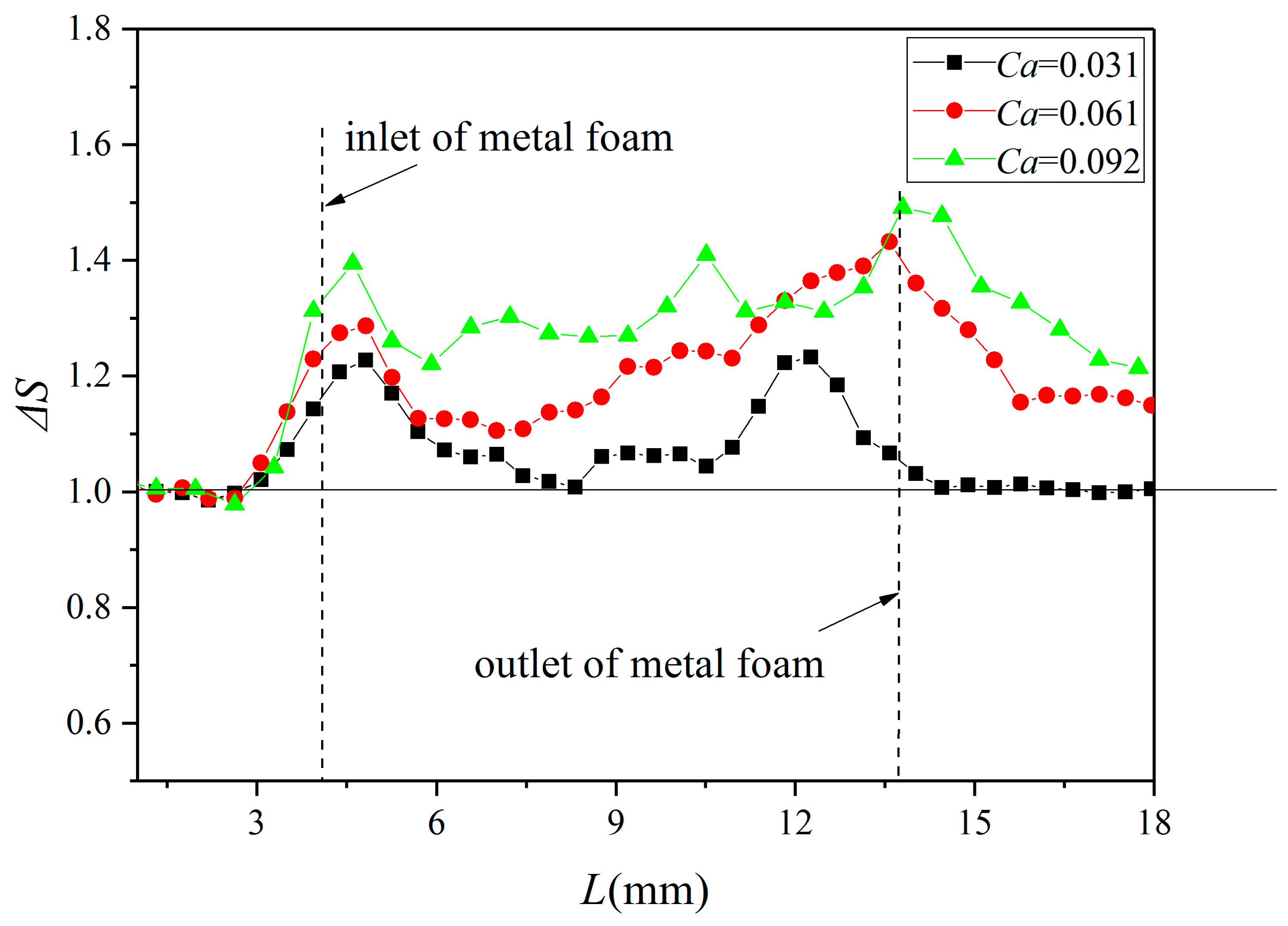
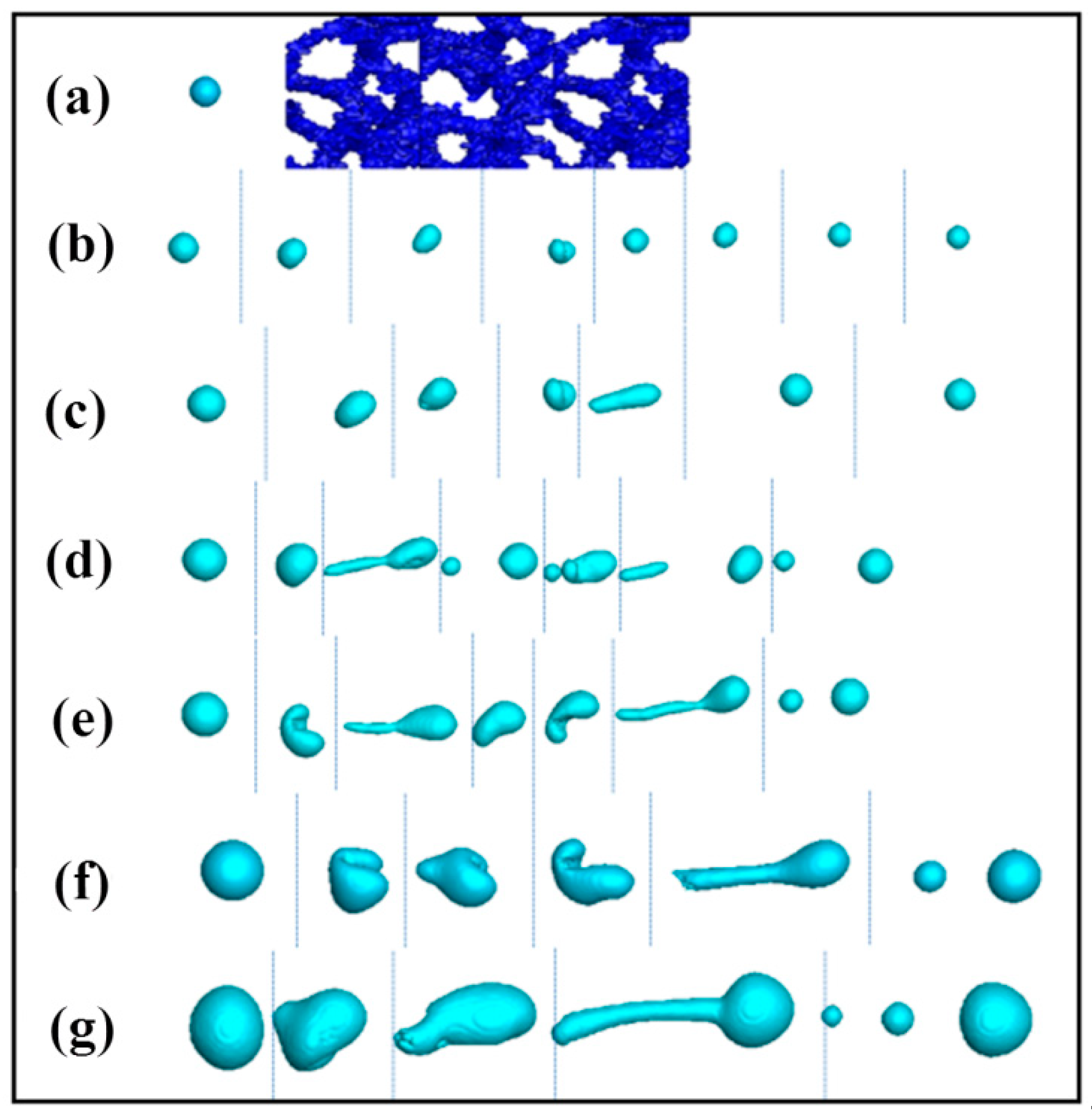


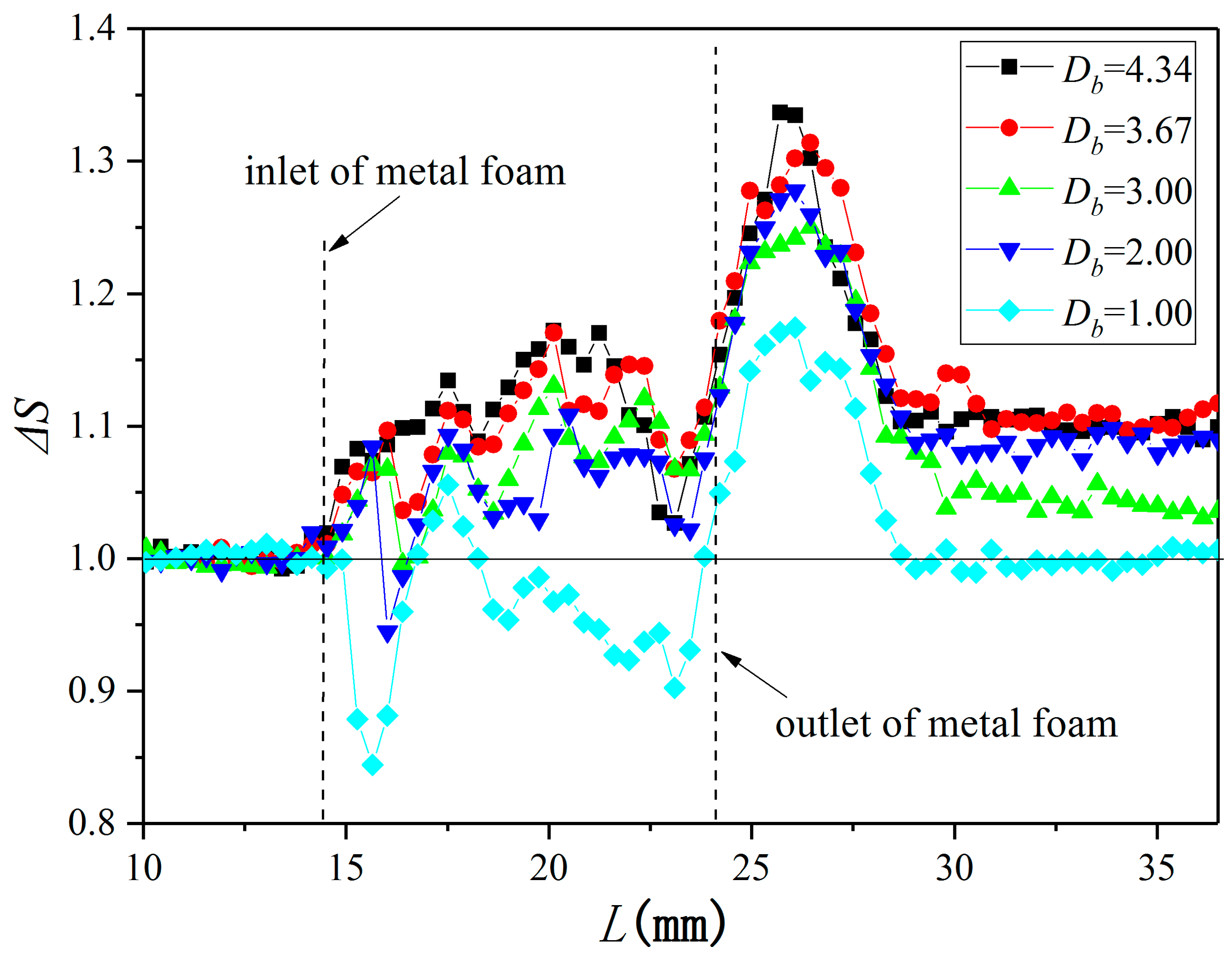
© 2019 by the authors. Licensee MDPI, Basel, Switzerland. This article is an open access article distributed under the terms and conditions of the Creative Commons Attribution (CC BY) license (http://creativecommons.org/licenses/by/4.0/).
Share and Cite
Zhang, J.; Yu, X.; Tu, S.-T. Lattice Boltzmann Simulation on Droplet Flow through 3D Metal Foam. Processes 2019, 7, 877. https://doi.org/10.3390/pr7120877
Zhang J, Yu X, Tu S-T. Lattice Boltzmann Simulation on Droplet Flow through 3D Metal Foam. Processes. 2019; 7(12):877. https://doi.org/10.3390/pr7120877
Chicago/Turabian StyleZhang, Jian, Xinhai Yu, and Shan-Tung Tu. 2019. "Lattice Boltzmann Simulation on Droplet Flow through 3D Metal Foam" Processes 7, no. 12: 877. https://doi.org/10.3390/pr7120877
APA StyleZhang, J., Yu, X., & Tu, S.-T. (2019). Lattice Boltzmann Simulation on Droplet Flow through 3D Metal Foam. Processes, 7(12), 877. https://doi.org/10.3390/pr7120877




